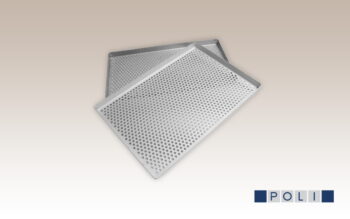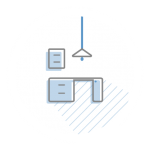Metalworking and die manufacturing for the medical sector
The characteristics of the medical sector are such that the use of metal components to manufacture equipment and systems is particularly advantageous.
Thanks to its extensive experience in cold forming, deep drawing and trimming of metal sheet, F.lli Poli provides some alternative solutions that allow to considerably decrease production costs while ensuring superior quality.
Materials
Medical settings need continuous sanitisation and washing involving the use of aggressive chemicals that are essential to ensure the equipment is bacteria-free. This frequent sanitisation leads to the deterioration of any parts made of plastic materials, which are particularly sensitive to aggressive environments.
Some particularly performing plastic materials (technopolymers) can be used for manufacturing components which are in direct contact with aggressive agents, but their cost is considerable and therefore their application is not cost-effective.
Hence, in these contexts, the use of stainless steel or anodized aluminium is particularly interesting.
Thanks to its features, the material is resistant and therefore suitable for creating self-supporting structures; additionally, it can be sanitised using aggressive agents without any risks of deterioration over time.
Current manufacturing technologies
The medical sector widely uses small to medium-sized equipment. Compact equipment is a huge advantage in controlled environments where the cost of space is significant.
Compact equipment normally implies that the components need to have some peculiar geometries and complex shapes, which you can normally obtain through bending and welding steps.
Welded parts are normally laser cut and undergo subsequent bending processes (before welding). In order to provide the required surface quality, welding is followed by pickling. The above-mentioned stages make the piece particularly expensive.
Alternative Technologies
It is possible to optimise the total cost of the equipment by implementing specific improvement activities:
- The first implies detecting some parts that are used continuously on several devices.
Components that are used in large quantities are isolated. These normally include brackets, hooks and small supports made by laser cutting or by bending in a press brake. For these components, it is worthwhile to manufacture small trimming and bending dies that allow to significantly reduce production costs. This technology allows significant savings. The bigger the quantities, the greater the advantages, resulting in a much faster payback of the dies.
It is also good practice to use the same components for further developing the equipment in the future, thus minimizing both production costs and the stocks that need to be kept to guarantee the delivery times of the equipment. - The second improvement activity consists in analysing the components that are made by welding several laser-cut and bent parts. It is often possible to redesign the component so that it can be manufactured as a single piece formed with deep drawing. This solution permits to reduce production costs considerably and improves the quality of the product both from a mechanical point of view (single and unwelded part) and from an aesthetic point of view (avoiding those unsightly weld seams).
The finished deep-drawn part is much more cost-effective than the one made by laser cutting and welding.
If the part is intended for containing liquids and/or if watertightness must be ensured, this system is by far the most performing and cost-effective.
F.lli Poli fully supports the optimization of production costs thanks to its 3D laser cutting technology.
This technology allows us to provide our clients with two specific advantages:
- We are effectively able to reduce the investment costs for the production of deep drawing dies by 3D-lasercutting the deep-drawn product, with complex geometry. No need to invest in a trimming die.
- If several versions of the same product are needed, we can very easily run some production batches with minor modifications to the openings and to the holes. This flexibility allows our clients to create customized products without having to significantly invest in dies.
Fill out the form below for more information





















